
I tested the output of the new XP-L led (XP-L V6 2C tint, from illumn.com) compared to a XM-L2 I had in the spare leds box (XM-L2 T6 3C, from Fasttech). Both were mounted on a 20mm copper Sinkpad, the XP-L on a xp-type and XM-L2 on a xm-type.
The introduction to this test is a bit longer than usual, to explain the altered method, up to now I did ceiling bounce light measurements, from now on I will use an integrating sphere.
I built the sphere a while ago, and after quite some testing and characterisation I am confident now to use it for measuring led output. The integrating properties of the sphere proved very good, I solved the serious variation caused by the relative big measurement hole (by building an adjustment light into the sphere), I solved why I got inconsistent readings from the sphere (a moving piece of tape  ), and now I think it really works, so from now on I will use the sphere for flashlight/emitter tests (if only because the measuring has become easier and more comfortable:I can do the tests sitting on a chair at the table now :-) ). Further reading about me building the sphere can be done here, although I still have to update the OP of that thread with how the integrating sphere was corrected and characterised.
), and now I think it really works, so from now on I will use the sphere for flashlight/emitter tests (if only because the measuring has become easier and more comfortable:I can do the tests sitting on a chair at the table now :-) ). Further reading about me building the sphere can be done here, although I still have to update the OP of that thread with how the integrating sphere was corrected and characterised.
The set-up for led-testing looks like this (last week I did another check on the current read-out of my power supply, it seems accurate at least within 0.1A):

The XP-L ledboard mounted on the copper pillar (soldered on a converted all-copper CPU-cooler):
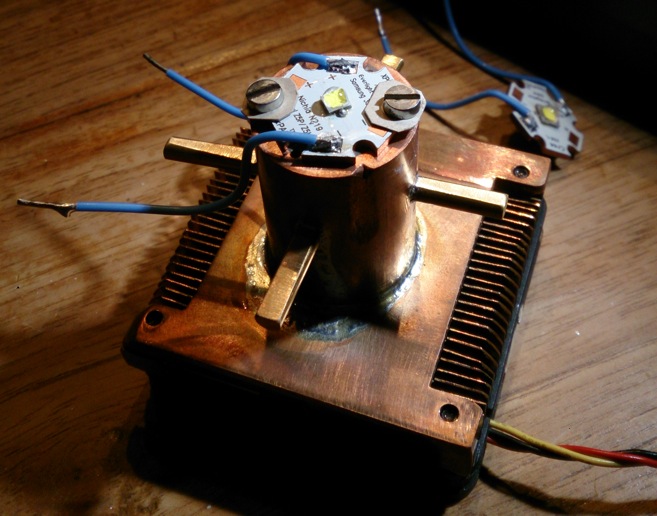
During the measurements it is inserted into the sphere like this:
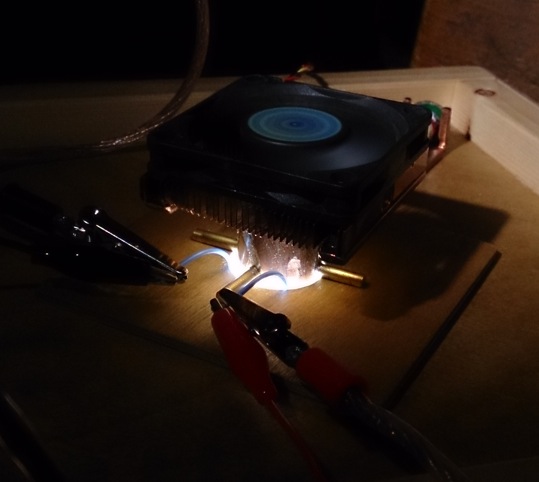
The ledboardwires that I use are pretty thick (can't remember the official thickness) but must be longer than when I did these kind of measurements using the ceiling bounce method, the two wires together are 12cm, so I needed to know the voltage drop over 12cm of this wire. Here's the result at 5A:
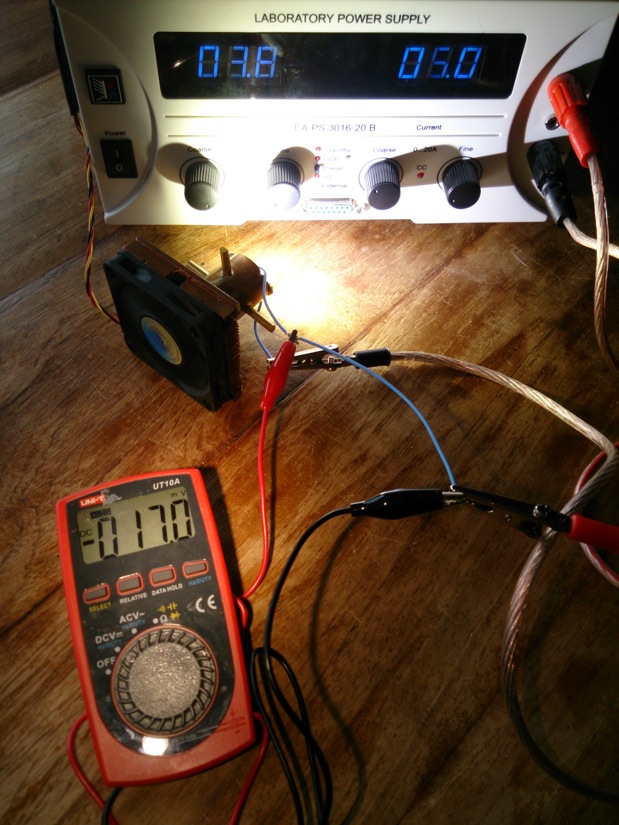
So it is only 17 mV at 5A current (0.017 V), that is pretty low IMO, for the graph numbers I will not substract that from the measured values. Whoever wants the voltage at the ledboard solder joint can easily calculate it (so that is a drop of 3.4mV/A), but in that case: you are probably also bothered with the voltage drop over the board traces, Relic38 showed to us that that is also not negligible  .
.
There is a magic conversion factor that I came up with, to convert the uncalibrated integrating sphere readings to lumen, it is 1.58. It is an estimated number, it came out of 'calibrating' the sphere with several flashlights with 'known' outputs, and previous measurements of leds using the ceiling bounce methods. It came pretty close to the official output of the high setting of my Sunwayman D40A: 550lm, so I decided to define the output on high of my D40A to be the official 550 lumen, the resulting conversion factor was 1.58. There is of course an annoying uncertainty in this number (and every D40A will be a bit different), it will not be way incorrect, but it can easily be 7 or 8% off the real value. To get that percentage down, I could use many more flashlights with official but still uncertain outputs, but the best way is to have a constant light source measured in another, calibrated sphere (and that will cost me 340 euro's  and that is not going to happen). So 1.58 will be the conversion factor for at least the coming period.
and that is not going to happen). So 1.58 will be the conversion factor for at least the coming period.
The XM-L2 T6 bare led output was measured before, by match. He measured it lower than I have here, about 7% lower. The calibration of his sphere was done the same way as I did now, using flashlights with known outputs that vary per unit, so I see no reason to adapt my calibration to his, also because the T6-bin is not exact, the emitters we tested could be at two ends of the T6 bin spectrum. (Texaspyro used home led lightbulbs for calibration because there's multiple leds in them, averaging out the differences between them, that could be a bit more accurate but is still not exact).
Ok, you get the picture of the method now: I think the measurements have gained a lot of consistency now that I am using the sphere, they can be compared very well to my future measurements and to any other measurements out there because I measure bare led lumens now, but if you ask for the true lumen numbers I can still not guarantee it within 1% , like I aimed for when building the sphere :-(
On to the tests: XP-L compared to the XM-L2 !
I first tested the XM-L2 up to 8.5A (the XM-L2 in my crashtest last year blew at that current, I am lucky with this one :-) ) . I did not go higher now because I still want to use the led (those XM-L2's do not come cheap). I measured by starting at low current and turning it up half an amp everytime, slowly, no rush. Although I did not let the output fully settle after each current increase, the output drop was so slow that in the graph you would not see the difference if I used fully settled outputs. To illustrate this: at 8.5A the measured output after 20 seconds was 2149 lumen, I let the output settle, and after 3 minutes it settled at 2127 lumen. The results match reasonably with what I measured last year, but the voltages are measured better (lower) now because last year I measured it using the (not so good, switching-mode) power supply voltage reading, not with a separate DMM close to the led.
I removed the mounting device from the sphere and estimated the temperature in the sphere by sticking my fingers in the hole: it was nice and warm, say 35 degC. I let it cool down to room temperature, and started a crash-test on the XP-L. It went all the way up to 10A before the bond wires were toast:
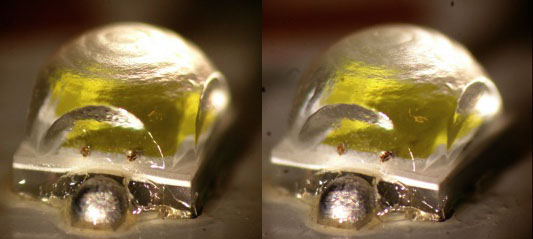
What striked was that the output was not that much higher than the XM-L2 T6, it had a clear maximum at 7.5A. and that the Vf is considerably higher than the XM-L2: as much as 0.3V at 6A current. There is of course a variance between different specimens of equally spec'ed leds but I think these differences are too significant for that.
This is what I measured in a graph:
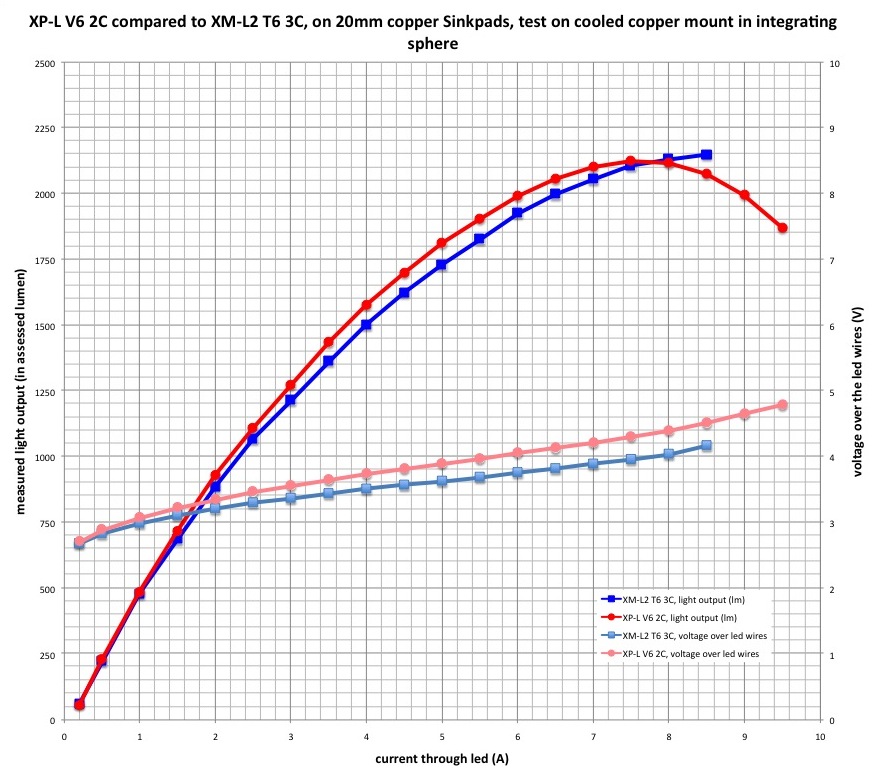
The more measurements I do, the less certain I am if what I am measuring is true (Confucius?  ). So I hope they make sense and are useful, I appreciate feedback if my numbers are at all in line with other experiences with this led. Thanks for reading!
). So I hope they make sense and are useful, I appreciate feedback if my numbers are at all in line with other experiences with this led. Thanks for reading!
EDIT 23/7/2014 some further testing of the XP-L in post#38

 ). So I hope they make sense and are useful, . . .
). So I hope they make sense and are useful, . . .